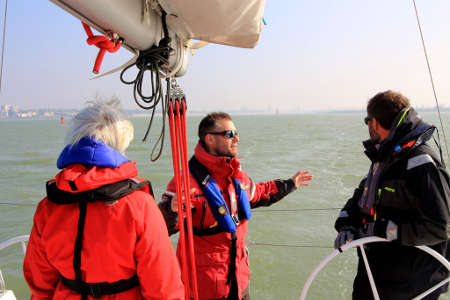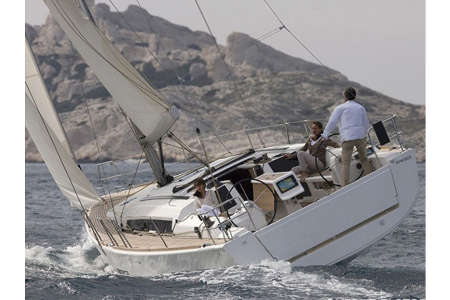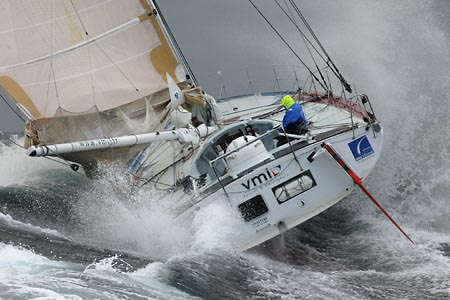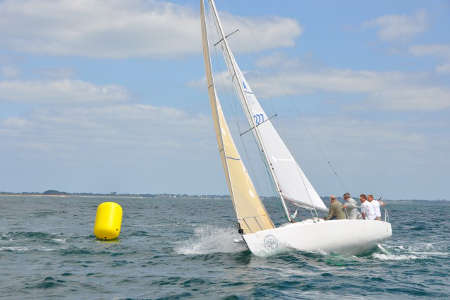From the first steps to nautical mastery, the journey can be long. While the sea is a magnificent playground, the dangers of practicing sailing are often underestimated. Coastal and offshore navigation therefore requires a minimum level of autonomy. This is acquired through experience, starting with serious training. The aspiring sailor must take care not to rush through their training path, ensuring they validate the skills acquired at each level. A coastal cruising or travel project must therefore be carefully prepared.


A recurring feeling among most beginner sailors can be summed up in the following phrase: the more we know, the more we feel like we know nothing! Indeed, as we move toward autonomy, we realize the extent of the practical and theoretical knowledge we must acquire. It is an excellent school of humility, a precious quality as soon as we step onto a boat. While the number of terms and concepts to learn may seem overwhelming to a beginner, the good news is that similar situations repeat on each sea outing. Gradually, the markers integrate and refine, leading progressively to a level of practice that opens the doors to the open sea, mastering the boat.
The novice must pass two major milestones to claim to sail autonomously.
The first level to achieve (usually after several weeks of sailing) is that of an autonomous crew member.
The Crew Member Role
A skilled crew member must be able to carry out all onboard maneuvers without the help of the captain. Their responsibilities mainly cover the following points.
Mooring the Boat
Mooring a boat requires knowing the functions of different mooring lines and common knots on board (cleat, chair, capstan, dead turn with two half-hitches...). A skilled crew member knows how to set up a spring line, a guard line, or a cross line, and place fenders in the right spots depending on the type of mooring.
Handling the Sails
A vital skill for the crew member is to know by heart the different types of maneuvers and their chronology: hoisting, lowering, trimming the sails, and also techniques for reducing sail area...
Steering the Course
A crew member must also be able to steer the boat and keep a course without deviating from it. The captain must be able to rely on them at all times. The crew member role thus requires developing listening and observation skills, no matter the situation.
An essential training step toward becoming a captain!
The Captain Role
The second step toward nautical mastery is transitioning to the role of captain. This time, no more vacations! There is no resting on the skipper in tough situations, one must face it. While the first steps as a boat’s captain can be stressful, one never learns more than when they can rely only on themselves. Gradually, one gets used to performing mental operations every moment, which is the daily life of a captain. At this stage, progress and fluidity accelerate. However, be careful not to confuse leadership with tyranny: the captain is primarily a coordinator who serves the boat's operation. This role is therefore mainly based on managing the following three parameters.
Managing the Crew
The first area of competence for a captain concerns the crew, with whom they must legitimize their authority through the demonstration of skills and character. This shows their ability to lead while ensuring safety, comfort, and a positive atmosphere onboard. Once trust is established, the captain must monitor several parameters: anticipate crew fatigue, prevent psychological stress, plan onboard tasks, manage shifts... and accept to be self-reflective!
Managing the Environment
The second area of competence for a captain concerns the boat’s environment. This involves analyzing the weather to choose the best possible route according to the navigation plan, while avoiding unnecessary risks in case of deterioration. This comes with time, and mistakes can be made... The crew must also show understanding and play along.
In case of trouble, the captain must be able to make the right decisions, especially in the event of an accident. That’s why "experience" is a crucial factor. Hence the necessity to "eat the miles" to gain real experience of risky situations.
Managing the Equipment
The third skill for a captain concerns boat maintenance. Various parts need monitoring, such as standing rigging (shrouds, mast condition, potential corrosion spots), running rigging (ropes and pulleys), and also the rudder, engine, hull, etc.
All these parameters make up a large program that will certainly occupy the skipper’s days. While the captain role does not prevent having a great vacation, it also involves responsibilities that must be seriously prepared for a smooth experience.
Heavy weather is a topic in its own right in your journey as a captain. It is one of the unavoidable factors to accept when sailing far, even on coastal cruises.
Therefore, it is essential to prepare for it as best as possible. To do so, don't hesitate to go sailing out of season with experienced sailors, of course, while avoiding any unnecessary risks!


In stressful situations, we easily lose 50% of our capabilities, or even more. A squall arrives and forces you to reduce sail in less than two minutes?
An engine failure forces you to drop anchor in a hurry to avoid running aground?
To manage an emergency well, there is only one solution: know the maneuvers and their chronology by heart, so that you can perform them without thinking.
This mix of experiences and knowledge will gradually lead you to autonomy, which will open the doors to the open sea.
After that, all that will be left for you to do is choose a project and set sail! With, of course, new experiences at every step that will allow you to become a seasoned sailor as the miles go by.
From the first steps to nautical mastery, the journey can be long. While the sea is a magnificent playground, the dangers of practicing sailing are often underestimated. Coastal and offshore navigation therefore requires a minimum level of autonomy. This is acquired through experience, starting with serious training. The aspiring sailor must take care not to rush through their training path, ensuring they validate the skills acquired at each level. A coastal cruising or travel project must therefore be carefully prepared.


A recurring feeling among most beginner sailors can be summed up in the following phrase: the more we know, the more we feel like we know nothing! Indeed, as we move toward autonomy, we realize the extent of the practical and theoretical knowledge we must acquire. It is an excellent school of humility, a precious quality as soon as we step onto a boat. While the number of terms and concepts to learn may seem overwhelming to a beginner, the good news is that similar situations repeat on each sea outing. Gradually, the markers integrate and refine, leading progressively to a level of practice that opens the doors to the open sea, mastering the boat.
The novice must pass two major milestones to claim to sail autonomously.
The first level to achieve (usually after several weeks of sailing) is that of an autonomous crew member.
The Crew Member Role
A skilled crew member must be able to carry out all onboard maneuvers without the help of the captain. Their responsibilities mainly cover the following points.
Mooring the Boat
Mooring a boat requires knowing the functions of different mooring lines and common knots on board (cleat, chair, capstan, dead turn with two half-hitches...). A skilled crew member knows how to set up a spring line, a guard line, or a cross line, and place fenders in the right spots depending on the type of mooring.
Handling the Sails
A vital skill for the crew member is to know by heart the different types of maneuvers and their chronology: hoisting, lowering, trimming the sails, and also techniques for reducing sail area...
Steering the Course
A crew member must also be able to steer the boat and keep a course without deviating from it. The captain must be able to rely on them at all times. The crew member role thus requires developing listening and observation skills, no matter the situation.
An essential training step toward becoming a captain!
The Captain Role
The second step toward nautical mastery is transitioning to the role of captain. This time, no more vacations! There is no resting on the skipper in tough situations, one must face it. While the first steps as a boat’s captain can be stressful, one never learns more than when they can rely only on themselves. Gradually, one gets used to performing mental operations every moment, which is the daily life of a captain. At this stage, progress and fluidity accelerate. However, be careful not to confuse leadership with tyranny: the captain is primarily a coordinator who serves the boat's operation. This role is therefore mainly based on managing the following three parameters.
Managing the Crew
The first area of competence for a captain concerns the crew, with whom they must legitimize their authority through the demonstration of skills and character. This shows their ability to lead while ensuring safety, comfort, and a positive atmosphere onboard. Once trust is established, the captain must monitor several parameters: anticipate crew fatigue, prevent psychological stress, plan onboard tasks, manage shifts... and accept to be self-reflective!
Managing the Environment
The second area of competence for a captain concerns the boat’s environment. This involves analyzing the weather to choose the best possible route according to the navigation plan, while avoiding unnecessary risks in case of deterioration. This comes with time, and mistakes can be made... The crew must also show understanding and play along.
In case of trouble, the captain must be able to make the right decisions, especially in the event of an accident. That’s why "experience" is a crucial factor. Hence the necessity to "eat the miles" to gain real experience of risky situations.
Managing the Equipment
The third skill for a captain concerns boat maintenance. Various parts need monitoring, such as standing rigging (shrouds, mast condition, potential corrosion spots), running rigging (ropes and pulleys), and also the rudder, engine, hull, etc.
All these parameters make up a large program that will certainly occupy the skipper’s days. While the captain role does not prevent having a great vacation, it also involves responsibilities that must be seriously prepared for a smooth experience.
Heavy weather is a topic in its own right in your journey as a captain. It is one of the unavoidable factors to accept when sailing far, even on coastal cruises.
Therefore, it is essential to prepare for it as best as possible. To do so, don't hesitate to go sailing out of season with experienced sailors, of course, while avoiding any unnecessary risks!


In stressful situations, we easily lose 50% of our capabilities, or even more. A squall arrives and forces you to reduce sail in less than two minutes?
An engine failure forces you to drop anchor in a hurry to avoid running aground?
To manage an emergency well, there is only one solution: know the maneuvers and their chronology by heart, so that you can perform them without thinking.
This mix of experiences and knowledge will gradually lead you to autonomy, which will open the doors to the open sea.
After that, all that will be left for you to do is choose a project and set sail! With, of course, new experiences at every step that will allow you to become a seasoned sailor as the miles go by.